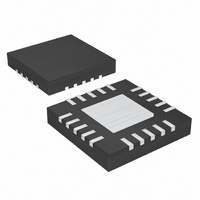MAX9737ETG+T Maxim Integrated Products, MAX9737ETG+T Datasheet - Page 9

MAX9737ETG+T
Manufacturer Part Number
MAX9737ETG+T
Description
IC AMP AUDIO 13W MONO D 24TQFN
Manufacturer
Maxim Integrated Products
Type
Class Dr
Datasheet
1.MAX9737ETG.pdf
(13 pages)
Specifications of MAX9737ETG+T
Output Type
1-Channel (Mono)
Max Output Power X Channels @ Load
13W x 1 @ 4 Ohm
Voltage - Supply
8 V ~ 28 V
Features
Depop, Mute, Short-Circuit and Thermal Protection, Shutdown
Mounting Type
Surface Mount
Package / Case
24-TQFN Exposed Pad
Lead Free Status / RoHS Status
Lead free / RoHS Compliant
When evaluating the MAX9737 with a ferrite bead filter
and resistive load, include a series inductor (68µH for
8Ω load and 33µH for 4Ω load) to model typical loud-
speaker’s behavior. Omitting the series inductor
reduces the efficiency, the THD+N performance and
the output power of the MAX9737. When evaluating
with a loudspeaker, no series inductor is required.
Some applications use the MAX9737 with a full induc-
tor/capacitor-based (LC) output filter. See Figure 4 for
the correct connections of these components.
The load impedance of the speaker determines the fil-
ter component selection (see Table 1).
Inductors L1 and L2 and capacitor C1 form the primary
output filter. Capacitors C2 and C3 provide common-
mode filtering to reduce radiated emissions. Capacitors
C4 and C5, plus resistors R1 and R2, form a Zobel at
the output. A Zobel corrects the output loading to com-
pensate for the rising impedance of the loudspeaker.
Without a Zobel, the filter exhibits peaking near the cut-
off frequency.
The output stage provides a fixed internal gain in addi-
tion to the externally set input stage gain. The fixed-out-
put stage gain is set at 13.6dB (4.8V/V). Set overall gain
by using resistors R
where A
between 10kΩ and 50kΩ.
The PRE terminal is an operational amplifier output,
allowing the MAX9737 to be configured as a filter or an
equalizer.
An input capacitor, C
resistor, R
that removes the DC bias from an incoming signal. The
AC-coupling capacitor allows the amplifier to bias the
signal to an optimum DC level. Assuming negligible
source impedance, the -3dB point of the highpass filter
is given by:
V
IN
is the desired voltage gain. Choose R
, of the MAX9737 forms a highpass filter
A
Inductor-Based Output Filters
V
_______________________________________________________________________________________
f
-3
=
F
dB
and R
-4 8 .
IN
=
, in conjunction with the input
2
⎛
⎜
⎝
π
R
R
IN
R C
Component Selection
IN
F
IN IN
1
(Figure 5) as follows:
⎞
⎟
⎠
Gain-Setting Resistors
V V
/
Input Capacitor
Mono 7W Class D Amplifier
F
Choose C
quency of interest. To reduce low-frequency distortion,
use capacitors whose dielectrics have low-voltage
coefficients. Capacitors with high-voltage coefficients
cause increased distortion close to f
and-pop suppression, use a 0.47µF input capacitor.
COM is the output of the internally generated DC bias
voltage. Bypass COM with a 1µF capacitor to AGND.
REG is the output of the internally generated DC bias
voltage. Bypass REG with a 1µF capacitor to AGND.
The MAX9737 features separate supplies for signal and
power portions of the device, allowing for the optimum
combination of headroom, power dissipation and noise
immunity. The speaker amplifiers are powered from
PVDD and can range from 8V to 28V. The remainder of
the device is powered by an internal 5V regulator, V
The MAX9737 features an internal 5V regulator, V
powered from PVDD. Bypass V
AGND.
Figure 4. LC Filter Configuration
Figure 5. Preamplifier Gain Configuration
AUDIO
INPUT
MAX9737
C
IN
IN
C
R
IN
COM
such that f
R
L1
L2
F
COM
PRE
-3dB
PC
IN
C2
C3
C1
is well below the lowest fre-
S
MAX9737
with a 1µF capacitor to
Regulator Capacitor
Power Supplies
C4
-3dB
C5
Internal Regulator
COM Capacitor
. For best click-
R1
R2
OUT+
OUT-
R
L
S
.
S
9
,











